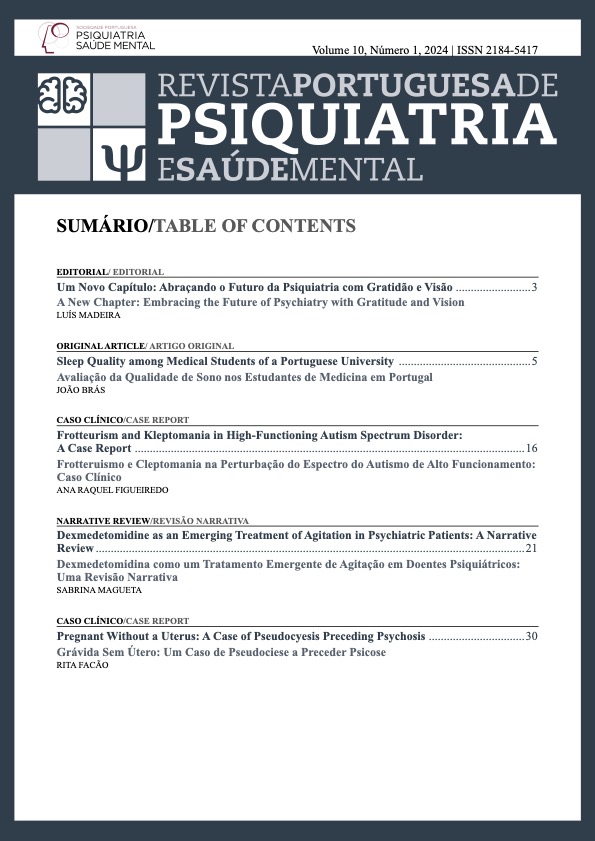Sleep Quality among Medical Students of a Portuguese University
DOI:
https://doi.org/10.51338/rppsm.496Keywords:
Sleep Initiation and Maintenance Disorders, Sleep Quality, Sleep Wake Disorders, Students, Medical, Surveys and QuestionnairesAbstract
Introduction: Sleep is a complex physiological process shared by most living beings. Sleep disorders have been increasing exponentially. University students, particularly medical students, are especially vulnerable to this problem. However, the existing literature on the subject is scarce, especially in Portugal. The aim of this study is to assess the quality of sleep among medical students attending the University of Beira Interior, Covilhã, Portugal and to analyse the differences and existing relationships according to age, gender, cohabitation status and academic year.Method: This is a cross-sectional study in which the students completed the Pittsburgh Sleep Quality Index (PSQI) that was previously validated for the Portuguese population. The values obtained for each component of the PSQI were initially analysed for the total sample, and then coupled with sociodemographic variables, in order to obtain statistically significant relationships.
Results: Two hundred and ninety-six students completed the questionnaire. A percentage of 62.2% of them stated that their sleep was good; 42.4% scored 2 in the component 2; 50% admitted that they usually sleep between 6 and 7 hours; 73.9% of the participants showed adequate sleep efficiency; 85.5% reported little or no sleep disturbance; 83.8% reported never having used sleep medications; and 60.8% mentioned little or no daytime disturbance. As for global PSQI score, 72.6% of the students’ scores were greater than 5, which indicates poor sleep quality. 74.7% of the female participants and 67.7% of the male respondents showed poor sleep quality. 91.3% of the students who were living alone at the time also revealed poor sleep quality. Of the 1st year students, 82.4% reported poor sleep quality, as did 77.5% of the 2nd year students, 72.1% of the 3rd year students, 77.8% of the 4th year students, 65.8% of the 5th year students, and 71.4% of those attending the 6th year.
Conclusion: Generally speaking, the students who took part in this study showed a poor sleep quality, with a PSQI score superior to 5. However, the ratings in each of the components are not so negative. Most of the participants rated their sleep as good or very good, almost half of the participants reported sleeping more than 7 hours and the majority had a sleep efficiency of more than 85%. Similarly, 83.8% had never used sleep medication. Since this is not a robust result, it is imperative to carry out more studies that unequivocally prove it. Moreover, such studies will also be essential to identify situations in which therapeutic intervention will improve such parameters.
Downloads
References
Schwartz WJ, Klerman EB. Circadian Neurobiology and the Physiologic Regulation of Sleep and Wakefulness. Neurol Clin. 2019;37:475–86. doi: 10.1016/j. ncl.2019.03.001
Falup Pecurariu C, Diaconu Ștefania, Țînț D, Falup Pecurariu O. Neurobiology of sleep (Review). Exp Ther Med. 2021;21:272. doi: 10.3892/etm.2021.9703
Saper CB. The Neurobiology of Sleep. CONTINUUM. 2013;19:19–31. doi: 10.1212/01. CON.0000427215.07715.73
Rosenwasser AM, Turek FW. Neurobiology of Circadian Rhythm Regulation. Sleep Med Clin. 2015;10:403–12. doi: 10.1016/j.jsmc.2015.08.003.
Borbély AA, Daan S, Wirz-Justice A, Deboer T. The two-process model of sleep regulation: A reappraisal. J Sleep Res. 2016;25:131–43. doi: 10.1111/jsr.12371.
Trachsel L, Edgar DM, Seidel WF, Craig Heller H. Sleep homeostasis in suprachiasmatic nuclei-lesioned rats: effects of sleep deprivation and triazolam administration. Brain Res. 1992;589:253–61. doi: 10.1016/00068993(92)91284-l.
Troynikov O, Watson CG, Nawaz N. Sleep environments and sleep physiology: A review. J Thermal Biol. 2018;78:192–203. doi: 10.1016/j. jtherbio.2018.09.012.
Albqoor MA, Shaheen AM. Sleep quality, sleep latency, and sleep duration: a national comparative study of university students in Jordan. Sleep Breath. 2021;25:1147–54. doi: 10.1007/s11325-020-02188-w.
Caddick ZA, Gregory K, Arsintescu L, Flynn-Evans EE. A review of the environmental parameters necessary for an optimal sleep environment. Build Environ. 2018;132:11–20. doi: 10.1016/j.buildenv.2018.01.020
Troynikov O, Watson CG, Nawaz N. Sleep environments and sleep physiology: A review. J Sleep Quality among Medical Students of a Portuguese University Therm Biol. 2018;78:192–203. doi: 10.1016/j.jtherbio.2018.09.012.
le Bon O. Relationships between REM and NREM inv the NREM-REM sleep cycle: a review on competing concepts. Sleep Med. 2020;70:6–16. doi: 10.1016/j. sleep.2020.02.004.
Brinkman JE, Reddy V, Sharma S. Physiology of Sleep [Internet]. In: StatPearls. Treasure Island: StatPearls Publishing; 2022 Jan [cited 2022 Oct 10]. Available from: https://www.ncbi.nlm.nih.gov/books/ NBK482512/.
Carley DW, Farabi SS. Physiology of Sleep. Diabetes Spectrum. 2016;29:5–9. doi: 10.2337/diaspect.29.1.5.
Paiva T, Penzel T. Centro de Medicina do Sono. Lisboa: Lidel; 2011.
Krueger JM, Frank MG, Wisor JP, Roy S. Sleep function: Toward elucidating an enigma. Sleep Med Rev. 2016;28:46–54. doi: 10.1016/j.smrv.2015.08.005.
Christova M, Aftenberger H, Nardone R, Gallasch E. Adult Gross Motor Learning and Sleep: Is There a Mutual Benefit? Neural Plasticity. 2018 :2018:3076986. doi: 10.1155/2018/3076986.
Assefa SZ, Diaz-Abad M, Wickwire EM, Scharf SM. The Functions of Sleep. AIMS Neurosci. 2015;2:155–1. doi: 10.3934/Neuroscience.2015.3.155
Gonçalves M, Peralta AR, Monteiro Ferreira J, Guilleminault C. Sleepiness and motor vehicle crashes in a representative sample of Portuguese drivers: the importance of epidemiological representative surveys. Traffic Inj Prev. 2015;16:677–83. doi: 10.1080/15389588.2015.1013535.
Gonçalves M, Amici R, Lucas R, Åkerstedt T, Cirignotta F, Horne J, et al. Sleepiness at the wheel across Europe: a survey of 19 countries. J Sleep Res. 2015;24:242–53. doi: 10.1111/jsr.12267.
Samouco AI, Almeida B, Soares CL, Machado C, Fragoeiro C, Caetano F, et al. A Ciência do Sono. Lisboa: Parsifal; 2020.
Krueger JM, Rector DM, Roy S, van Dongen HPA, Belenky G, Panksepp J. Sleep as a fundamental property of neuronal assemblies. Nat Rev Neurosci. 2008;9:910–9. doi: 10.1038/nrn2521.
Liu T, Jiang CY, Fujita T, Luo SW, Kumamoto E. Enhancement by interleukin‐ 1β of AMPA and NMDA receptor‐mediated currents in adult rat spinal superficial dorsal horn neurons. Mol Pain. 2013;9:1744-8069-9–16. doi: 10.1186/1744-8069-9-16.
Churchill L, Rector DM, Yasuda K, Fix C, Rojas MJ, Yasuda T, et al. Tumor necrosis factor α: Activity dependent expression and promotion of cortical column sleep in rats. Neuroscience. 2008;156:71–80. doi: 10.1016/j.neuroscience.2008.06.066.
De A, Krueger JM, Simasko SM. Tumor necrosis factor α increases cytosolic calcium responses to AMPA and KCl in primary cultures of rat hippocampal neurons. Brain Res. 2003;981:133–42. doi: 10.1016/ s00068993(03)02997-4.
Al-Khani AM, Sarhandi MI, Zaghloul MS, Ewid M, Saquib N. A cross-sectional survey on sleep quality, mental health, and academic performance among medical students in Saudi Arabia. BMC Res Notes. 2019;12:665. doi: 10.1186/s13104-019-4713-2.
Mohammadbeigi A, Absari R, Valizadeh F, Saadati M, Sharifimoghadam S, Ahmadi A, et al. Sleep Quality in Medical Students; the Impact of Over-Use of Mobile Cell-Phone and Social Networks. J Res Health Sci. 2016;16:46-50.
Blanco C, Okuda M, Wright C, Hasin DS, Grant BF, Liu SM, et al. Mental health of college students and their non-college-attending peers: Results from the national epidemiologic study on alcohol and related conditions. Arch Gen Psychiatry. 2008;65:1429–37. doi: 10.1001/archpsyc.65.12.1429
Wang F, Bíró É. Determinants of sleep quality in college students: A literature review. EXPLORE. 2021;17:170–7.
Gomes A, Tavares J, Pinto de Azevedo MH. Padrões de sono em estudantes universitários portugueses. Acta Med Port. 2009;22:545-52. doi: 10.1016/j. explore.2020.11.003.
Reis M, Ramiro L, Paiva T, Gaspar-de-Matos M. National Survey on the importance of sleep in the quality of academic life and mental health of college students in Portugal. Sleep Sci. 2021;14: 125-132. doi: 10.5935/1984-0063.20200090.
Azad MC, Fraser K, Rumana N, Abdullah AF, Shahana N, Hanly PJ, et al. Sleep Disturbances among Medical Students: A Global Perspective. J Clin Sleep Med. 2015;11:69–74. doi: 10.5664/jcsm.4370.
Jahrami H, Dewald-Kaufmann J, Faris MA, AlAnsari AM, Taha M, et al. Prevalence of sleep problems among medical students: a systematic review and meta-analysis. J Public Health. 2020; 28, 605-22. doi: 10.1007/s10389-019-01064-6
Alsaggaf MA, Wali SO, Merdad RA, Merdad LA. Sleep quantity, quality, and insomnia symptoms of medical students during clinical years. Saudi Med J. 2016;37:173–82. doi: 10.15537/smj.2016.2.14288.
Ahrberg K, Dresler M, Niedermaier S, Steiger A, Genzel L. The interaction between sleep quality and academic performance. J Psychiatr Res. 2012;46:1618–22. doi: 10.1016/j.jpsychires.2012.09.008.
Gardani M, Bradford DRR, Russell K, Allan S, Beattie L, Ellis JG, et al. A systematic review and meta-analysis of poor sleep, insomnia symptoms and stress in undergraduate students. Sleep Med Rev. 2022;61:101565. doi: 10.1016/j.smrv.2021.101565.
Rathakrishnan B, Singh SS, Kamaluddin MR, Yahaya A, Nasir MA, Ibrahim F, et al. Smartphone addiction and sleep quality on academic performance of university students: An exploratory research. Int J Environ Res Public Health. 2021;18. doi: 10.3390/ ijerph18168291.
Zhong Y, Ma H, Liang YF, Liao CJ, Zhang CC, Jiang WJ. Prevalence of smartphone addiction among Asian medical students: A meta-analysis of multinational observational studies. Int J Soc Psychiatry. 2022;68:117183. doi: 10.1177/00207640221089535.
Buysse DJ, Reynolds CF 3rd, Monk TH, Berman SR, Kupfer DJ. The Pittsburgh Sleep Quality Index: a new instrument for psychiatric practice and research. Psychiatry Res. 1989;28:193-213. doi: 10.1016/01651781(89)90047-4.
Del Rio JK, Becker NB, de Neves Jesus S, Santos Martins IR. Validation of the Portuguese version of the Pittsburgh Sleep Quality Index (PSQI-PT). Psychiatry Res. 2017;247:225-9. doi: 10.1016/j. psychres.2016.11.042.
Angerer P, Schmook R, Elfantel I, Li J. Night Work and the Risk of Depression. Dtsch Arztebl Int. 2017;114:404-11. doi: 10.3238/arztebl.2017.0404.
Pavlova M, Latreille V. Sleep disorders. Am J Med. 2019;132:292–9. doi: 10.1016/j.amjmed.2018.09.021.
Reis C, Dias S, Rodrigues AM, Sousa RD, Gregório MJ, Branco J, et al. Sleep duration, lifestyles and chronic diseases: A cross-sectional population-based study. Sleep Sci. 2018;11:217–30. doi: 10.5935/19840063.20180036.
Gaultney JF. The prevalence of sleep disorders in college students: impact on academic performance. J Am Coll Health. 2010;59:91–7. doi: 10.1080/07448481.2010.483708.
Corrêa CC, Oliveira FK, Pizzamiglio DS, Ortolan EV, Weber SA. Sleep quality in medical students: a comparison across the various phases of the medical course. J Bras Pneumol. 2017;43:285-9. doi: 10.1590/ S180637562016000000178.
Gupta S, Bhardwaj A, Nadda A, Gill A, Mittal A, Gupta S. A comparative study of sleep quality in different phases of the medical course: A study from Haryana (North India). J Family Med Prim Care. 2020;9:2006. doi: 10.4103/jfmpc.jfmpc_1137_19.
46. Sweileh WM, Ali IA, Sawalha AF, Abu-Taha AS, Zyoud SH, Al-Jabi SW. Sleep habits and sleep problems among Palestinian students. Child Adolesc Psychiatry Ment Health. 2011;5:25. doi: 10.1186/1753-2000-5-25.
Lemma S, Patel SV, Tarekegn YA, Tadesse MG, Berhane Y, Gelaye B, et al. The Epidemiology of Sleep Quality, Sleep Patterns, Consumption of Caffeinated Beverages, and Khat Use among Ethiopian College Students. Sleep Disord. 2012;2012:583510. doi: 10.1155/2012/583510.
Lund HG, Reider BD, Whiting AB, Prichard JR. Sleep patterns and predictors of disturbed sleep in a large population of college students. J Adolesc Health. 2010;46:124–32. doi: 10.1016/j. jadohealth.2009.06.016.
Al-Sayed AA, Al-Rashoudi AH, Al-Eisa AA, Addar AM, Al-Hargan AH, AlJerian AA, et al. Sedative Drug Use among King Saud University Medical Students: A Cross-Sectional Sampling Study. Depress Res Treat. 2014;2014:1–7. doi: 10.1155/2014/378738.
Rique GL, Fernandes Filho GM, Ferreira AD, de Sousa-Muñoz RL. Relationship between chronotype and quality of sleep in medical students at the Federal University of Paraiba, Brazil. Sleep Sci. 2014;7:961. doi: 10.1016/j.slsci.2014.09.004.
Sundas N, Ghimire S, Bhusal S, Pandey R, Rana K, Dixit H. Sleep quality among medical students of a tertiary care hospital: a descriptive crosssectional study. J Nepal Med Assoc. 2020;58:222. doi: 10.31729/ jnma.4813.
Suh S, Cho N, Zhang J. Sex Differences in insomnia: from epidemiology and etiology to intervention. Curr Psychiatry Rep. 2018;20:69. doi: 10.1007/ s11920-018-0940-9.
Amaral AP, Bos SC, Soares MJ, Pereira AT, Marques M, Madeira N, et al. Personality, cognitive emotion regulation and insomnia. Arch Clin Psychiatry. 2021;48: 29-35. doi: 10.1590/0101-60830000000275
Riemann D, Krone LB, Wulff K, Nissen C. Sleep, insomnia, and depression. Neuropsychopharmacology. 2020;45:74-89. doi: 10.1038/s41386-0190411-y.








